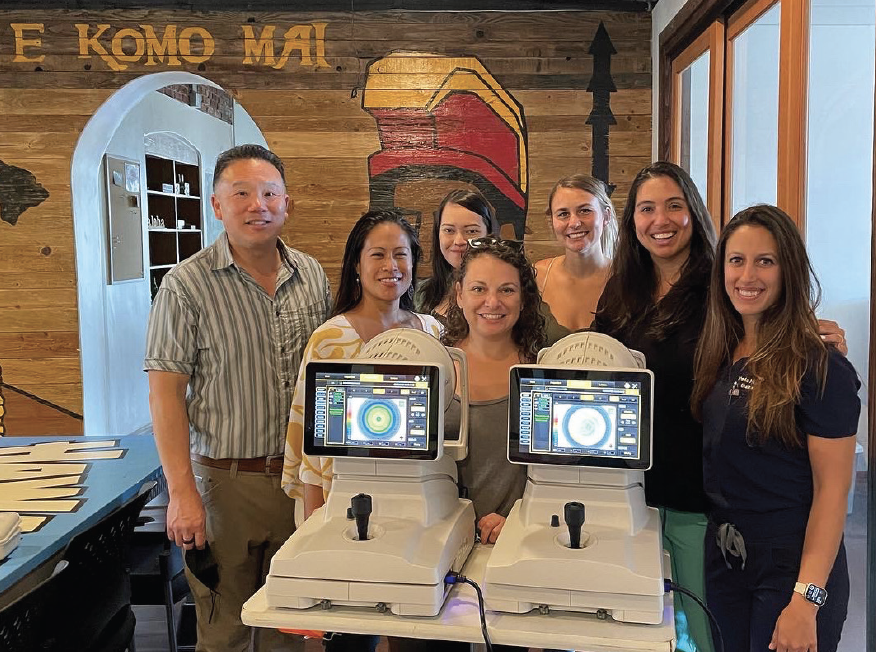
Despite the effectiveness of CXL at slowing or halting the progression of keratoconus, this and other ectatic corneal disorders remain the leading causes of penetrating keratoplasty in the United States.1 Unfortunately, many individuals go blind from keratoconus for a multitude of reasons. The main one is a delay in diagnosis and treatment.
I believe we can eradicate avoidable blindness from keratoconus in our lifetime and dramatically reduce the number of corneal transplants being performed. This goal requires a grassroots approach to increasing awareness and identifying patients at a young age. School screenings are a logical first step.
BREAKing THE CYCLE
Many individuals with keratoconus are school-aged children who struggle to see in class. Their poor vision can reduce their academic achievements and limit their future career opportunities. One prospect to break the cycle is to screen for keratoconus in schools. School screening programs have been successfully implemented in places such as Saudi Arabia,3 In Hawaii, where I practice, we are piloting a keratoconus screening program with help from a local nonprofit organization. Project Vision Hawaii (PVH) is a 501(c)(3) corporation founded in 2007. Since its inception, PVH has provided free mobile medical screening services to more than 130,000 patients across the Hawaiian Islands.
PVH’s Better Vision for Keiki (keiki is Hawaiian for child) is a school screening program that operates in conjunction with the local government and the Hawai’i State Department of Education to identify children with visual impairment and refer them to their partner organization, Vision to Learn, for an optometric examination and glasses. Through the Vision for Keiki program, 20,000 to 30,000 students are screened annually at local public and charter schools. Additionally, Vision to Learn has provided about 4,000 free pairs of eyeglasses to school-aged students.
ADDING KERATOCONUS SCREENING
PVH has partnered with the ophthalmic industry to add keratoconus screening to the Better Vision for Keiki program. The organization has purchased corneal topography devices through a grant from the iDetect Program (Glaukos/Topcon) and trained PVH’s health care workers to use the technology (Figures 1 and 2). Over the past year, Aloha Laser Vision has worked closely with the leadership of PVH to educate them and their health care workers about keratoconus. We have developed preliminary protocols for topography and keratoconus screening, which will be added to the organization’s established school screening protocol in the 2022 to 2023 school year.

Figure 1. Dr. Nikpoor (far right) with PVH Better Vision for Keiki health care professionals.

Figure 2. PVH health care professionals undergoing training on keratoconus screening.
Keratoconus screenings are currently being conducted outside of schools to test the program before large-scale implementation. Suspicious and equivocal keratoconus cases are referred to a provider for further evaluation with topography. If (and more likely when) keratoconus is diagnosed, we hope and believe that we will be able to treat patients with CXL when appropriate through Medicaid and financial aid programs. (Medicaid covers CXL in Hawaii.)
A LARGER EFFORT
The addition of keratoconus screening to the Better Vision for Keiki program is part of a larger effort to identify at-risk populations and target our island’s screening efforts. This is especially important for the Big Island, where the incidence of keratoconus is higher than that of Hawaii’s total population. At our practice, 29% of patients require CXL (unpublished data, retrospective chart review) compared to about 14% of the state population.4 Furthermore, we have observed more advanced keratoconus on the island of Oahu. Environmental factors likely play a role in the difference in disease severity.
Aloha Laser Vision uses AvaGen genetic testing (Avellino) and has partnered with Avellino to study the genetics of keratoconus in Hawaii. If we can identify specific populations that are at increased risk of developing the disease, our plan is to partner with PVH, local government, media, and cultural groups to raise awareness about keratoconus and encourage at-risk groups to visit eye care providers for screening. Additionally, we plan to use the data to target high-risk school districts with more frequent and earlier screening programs.
CONCLUSION
The pilot school keratoconus screening program is in the early stages of development. We hope to provide proof of concept that patients with keratoconus who otherwise would have gone undiagnosed can be identified and treated. If the program is successful, we plan to apply for more funding. Our hope is that similar keratoconus school screening programs will be developed across the nation.
1. 2019 eye banking statistical report. Eye Bank Association of America. 2020. Accessed March 14, 2022. https://restoresight.org/wp-content/uploads/2020/04/2019-EBAA-Stat-Report-FINAL.pdf
2. Torres Netto EA, Al-Otaibi WM, Hafezi NL, et al. Prevalence of keratoconus in paediatric patients in Riyadh, Saudi Arabia. Br J Ophthalmol. 2018;102(10):1436-1441.
3. Moshirfar M, Heiland MB, Rosen DB, Ronquilly YC, Hoopes PC. Keratoconus screening in elementary school children. Ophthalmol Ther. 2019;8(3):367-371.
4. Quick Facts: Hawaii County, Hawaii. US Census Bureau. July 1, 2021. Accessed March 14, 2022. https://www.census.gov/quickfacts/fact/table/hawaiicountyhawaii/PST045221




